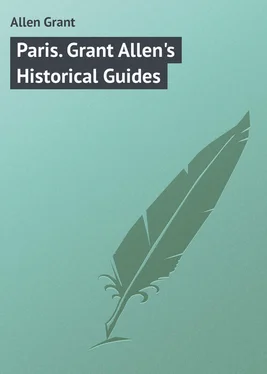Grant Allen - Paris. Grant Allen's Historical Guides
Здесь есть возможность читать онлайн «Grant Allen - Paris. Grant Allen's Historical Guides» — ознакомительный отрывок электронной книги совершенно бесплатно, а после прочтения отрывка купить полную версию. В некоторых случаях можно слушать аудио, скачать через торрент в формате fb2 и присутствует краткое содержание. ISBN: , Издательство: Иностранный паблик, Жанр: foreign_language, foreign_prose, на английском языке. Описание произведения, (предисловие) а так же отзывы посетителей доступны на портале библиотеки ЛибКат.
- Название:Paris. Grant Allen's Historical Guides
- Автор:
- Издательство:Иностранный паблик
- Жанр:
- Год:неизвестен
- ISBN:http://www.gutenberg.org/ebooks/49907
- Рейтинг книги:4 / 5. Голосов: 1
-
Избранное:Добавить в избранное
- Отзывы:
-
Ваша оценка:
- 80
- 1
- 2
- 3
- 4
- 5
Paris. Grant Allen's Historical Guides: краткое содержание, описание и аннотация
Предлагаем к чтению аннотацию, описание, краткое содержание или предисловие (зависит от того, что написал сам автор книги «Paris. Grant Allen's Historical Guides»). Если вы не нашли необходимую информацию о книге — напишите в комментариях, мы постараемся отыскать её.
Paris. Grant Allen's Historical Guides — читать онлайн ознакомительный отрывок
Ниже представлен текст книги, разбитый по страницам. Система сохранения места последней прочитанной страницы, позволяет с удобством читать онлайн бесплатно книгу «Paris. Grant Allen's Historical Guides», без необходимости каждый раз заново искать на чём Вы остановились. Поставьте закладку, и сможете в любой момент перейти на страницу, на которой закончили чтение.
Интервал:
Закладка:
Open daily, all day long, free. Take your opera-glasses.]
Go along the Rue de Rivoli as far as the Square of the Tour St. Jacques. Walk through the little garden. Notice, in passing, *the tower – all that now remains of the church of St. Jacques-de-la-Boucherie – used at present as a meteorological observatory. Turn down the Rue St. Martin to the Pont Notre-Dame. In front, L, stands the Hôtel-Dieu; R, the Tribunal de Commerce; centre, the Marché-aux-Fleurs; at its back, the Prefecture de Police. Continue straight along the Rue de la Cité, passing, R, the main façade of the modern Palais de Justice (with a glimpse of the Ste. Chapelle) till you come to the broad and open Place Notre-Dame (generally known by its mediæval name of the Parvis). Take a seat under the horse-chestnuts on the north side of the Place, opposite the equestrian statue of Charlemagne, in order to examine the façadeof the cathedral.
The **west front, dating from the beginning of the 13th century (later than the rest), consists of two stories, flanked by towers of four stories. The first story contains the three main portals: L, the door of Our Lady; centre, of her Son; R, of her Mother. On the buttresses between them stand four statues: extreme L, St. Stephen; extreme R, St. Marcel, Bishop of Paris (a canonized holder of this very see); centre L, the Church, triumphant; centre R, the Synagogue, dejected (representing between them the Law and the Gospel). This first story is crowned and terminated by the Galerie des Rois, containing figures of the kings of Israel and Judah, ancestors of the Blessed Virgin (others say, kings of France to the date of the building), destroyed in the great Revolution, but since restored. On the parapet above it stand, R and L, Adam and Eve; centre, Our Lady and Child with two adoring angels – the Fall and the Redemption. The second story contains the great rose window and two side-arches with double windows. The third story of the towers consists of a graceful open-work screen, continued in front of the nave, so as to hide its ugly gable (which is visible from further back in the Place), thus giving the main front a fallacious appearance of having three stories. The final or fourth story of the towers is pierced on each side by two gigantic windows, adding lightness to their otherwise massive block. The contemplated spires have never been added. This façade has been copied with modifications in many other French cathedrals.
Now approach the front, to examine in detail the **great portals, deeply recessed, as is usual in French cathedrals, owing to the massive masonry of the towers. The left or northern doorway – that of Our Lady(by which her church is usually entered) bears on its central pier a statue of the Virgin and Child; beneath her feet are scenes from the temptation of Eve, who brought into the world sin, and the first murderer Cain, as contrasted with her descendant, the Blessed Virgin, who brought into the world the Redeemer of mankind. Over Our Lady’s head, a tabernacle, representing the relics preserved within. In the tympanum, first tier, L, three patriarchs; R, three kings, typifying the ancestors of the Blessed Virgin. Above, second tier, the Entombment of the Virgin, placed in her sarcophagus by angels, and attended by the apostles with their familiar symbols. Higher still, third tier, the Coronation of the Virgin, in the presence of her Son, with adoring angels. The whole thus represents the Glory of Our Lady. At the sides below, life-size figures; extreme L, Constantine, first Christian Emperor; extreme R, Pope Silvester, to whom he is supposed to have given the patrimony of St. Peter – the two representing the union of Church and State. Next to these the great local saints: L, St. Denis, bearing his head, and guided by two angels; R, St. John Baptist, St. Stephen, and Ste. Geneviève, with the devil endeavouring to extinguish her taper, and a sympathizing angel. The figures on the arch represent spectators of the Coronation of the Virgin. Minor subjects – signs of the Zodiac, Months, etc. – I leave to the ingenuity and skill of the reader. The * centre doorway (commonly called the Porte du Jugement) is that of the Redeemer, Our Lady’s Son; on its central pier, fine modern figure of Christ blessing; above, in the tympanum, the usual Last Judgment. First tier (modern) the General Resurrection, with angels of the last trump, and kings, queens, bishops, knights, etc., rising from their tombs; conspicuous among them is naturally St. Stephen. Second tier, St. Michael the Archangel weighing souls, with devils and angels in waiting, the devils cheating; R, the wicked (on Christ’s left) hauled in chains to hell; L, the saints (on His right) ascending to glory. On the summit, third tier, the New Jerusalem, with Christ enthroned, showing His wounds in mercy, flanked by adoring angels holding the cross, spear, and nails; L, the Blessed Virgin, patroness of this church; and R, Ste. Geneviève, patroness of Paris, interceding for their votaries. (Last figure is usually, but I think incorrectly, identified as St. John the Evangelist, who has no function on a Parisian Cathedral.) This relief, closely copied at the Ste. Chapelle, is itself imitated from one at St. Denis. On the lintels the Wise (L) and Foolish (R) Virgins; L and R on jambs, life-size figures of the Twelve Apostles, with their usual symbols. Observe the beautiful ironwork of the hinges. The third or southern portal, that of St. Anne – the Mother of the Virgin– contains older work than the other two, replaced from the earlier church on the same site. The style of the figures is therefore Romanesque, not Gothic; so is the architecture represented in them. On the centre pier, St. Marcel, Bishop of Paris. Above, tympanum, history of St. Anne; first tier, centre, the meeting of Joachim and Anna at the Golden Gate; L, Marriage of the Virgin; R, her Presentation by St. Anne in the Temple, etc. Second tier, the Nativity, and the visit of the Magi to Herod; at the summit, third tier, Madonna enthroned, with adoring angels, a king, and a bishop – Church and State once more identified. The work on this doorway much resembles that at St. Denis. Magnificent iron hinges, brought from old St. Stephen’s.
Walk round the quay on the South side to examine the body of the church. Notice the lofty Nave, and almost equally lofty Aisles, with (later) side-chapels built out as far as the level of the Transept; also, the flying buttresses. As in most French churches, the transepts are short, and project but little from the aisles. The South Transept has a good late façade with two rose-windows. Its portal – ill visible – is dedicated (in compensation) to the displaced St. Stephen, and contains on the pier a figure of the saint, robed, as usual, as a deacon; in the tympanum are reliefs of his preaching, martyrdom, death, and glorification. Note, to the R, a small relief of St. Martin of Tours dividing his cloak with the beggar.
Enter the little garden further east, which occupies the site of the former archevêché, in order to observe the characteristic French form of the choir– a lofty and narrow apse, with apsidal aisles and circular chapels added below, the whole forming what is called a chevet . The light flying buttresses which support the soaring and slender choir add greatly to the beauty and picturesqueness of the building. Pretty modern Gothic fountain. Quit the garden and continue round the Northern side of the Cathedral. The first (small) door at which we arrive – the Porte Rouge – admits the canons. It is a late addition, built in 1407 by Jean sans Peur, Duke of Burgundy, in expiation of his murder of the Duke of Orleans; the donor and his wife kneel on each side of the Coronation of the Virgin in the tympanum. Notice here the gargoyles and the graceful architecture of the supports to the buttresses. The second (larger) door – the Portail du Cloître, so called from the cloisters long demolished – in the North Transept contains a good statue of the Madonna on the pier; above, in the tympanum, confused figures tell obscurely the legend of the monk Theophilus, who sold his soul to the devil. Stand opposite this door, on the far pavement, to observe the architecture of the North Transept. The best point of view for the whole body of the cathedral, as distinct from the façade , can be obtained from the Quai de Montebello on the south side of the river.
Читать дальшеИнтервал:
Закладка:
Похожие книги на «Paris. Grant Allen's Historical Guides»
Представляем Вашему вниманию похожие книги на «Paris. Grant Allen's Historical Guides» списком для выбора. Мы отобрали схожую по названию и смыслу литературу в надежде предоставить читателям больше вариантов отыскать новые, интересные, ещё непрочитанные произведения.
Обсуждение, отзывы о книге «Paris. Grant Allen's Historical Guides» и просто собственные мнения читателей. Оставьте ваши комментарии, напишите, что Вы думаете о произведении, его смысле или главных героях. Укажите что конкретно понравилось, а что нет, и почему Вы так считаете.












